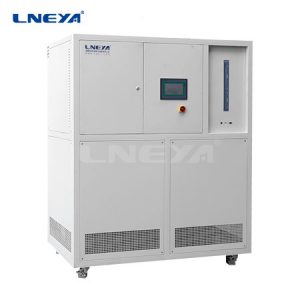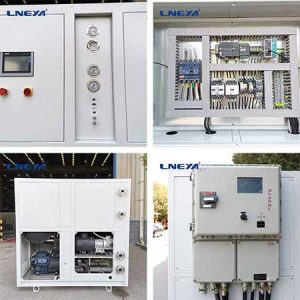What is the 50 ton chiller for?
(1) Electronic industry: It is mainly used to stabilize the molecular structure of electronic components in the production line and improve the qualification rate of electronic components.

(2) Ultrasonic cleaning industry: use cold water to effectively prevent the volatilization of cleaning agent and the harm caused by volatilization.
(3) Plastic industry: through the chiller, it can accurately control the mold temperature of various plastic processing, shorten the beer molding cycle, and ensure the stability of product quality.
(4) Food industry: used for high-speed cooling after food processing to meet the packaging requirements; In addition, it can also control the temperature of fermented food.
(5) Pharmaceutical industry: In the pharmaceutical industry, water chillers are mainly used for temperature control of fermented drugs.

(6) Electroplating industry: It can control the electroplating temperature, increase the density and smoothness of the plated parts, shorten the electroplating cycle, improve production efficiency and improve product quality.
(7) Vacuum coating: control the temperature of the vacuum coating machine to ensure the high quality of the coated parts.
(8) Mechanical industry: in the field of mechanical industry, the use of water chillers can control the pressure oil temperature of the oil pressure system, stabilize the oil temperature and oil pressure, extend the service time of oil quality, improve the efficiency of mechanical lubrication and reduce wear.
(9) Construction industry: it is mainly to provide chilled water for concrete, so that the molecular structure of concrete can meet the requirements of construction purposes, and enhance the hardness and toughness of concrete.

1. Installation of LC -25°C ~ -5°C Low Temperature Chillers.
When installing the water chiller, pay attention not to damage the unit, and reasonably arrange the space around the water chiller to facilitate the maintenance of the water chiller.
According to the recognized pipeline system design and construction and installation standards, the chilled water and cooling water system shall be reasonably designed and installed to give full play to the performance of the chiller.
The unit shall be placed horizontally and installed in a ventilated place.
When the environment around the water source and cooling water tower is bad, Y-type filter must be installed on the chilled water and cooling water circuit, and the exhaust valve must be installed at the highest position of the closed chilled water system at regular intervals, and the drainage joint must be installed at the lowest position of the system for system drainage.
Select the appropriate cooling tower according to the refrigeration capacity of the unit.
After the leakage test of the chilled water pipe, the insulation room shall be packaged to avoid the loss of cooling capacity and pipe dripping.
2. Water chiller power connection.
The power supply of the water chiller is three-phase four-wire, and the unit is connected to the column in the electrical control box with the main power line through the hole in the electrical control box to ensure that the connection becomes firm each time.
Unit power distribution requirements: main power supply voltage: within ± 10% of rated voltage, and main power supply frequency: within ± 2%.
When the voltage fluctuation of the main power supply exceeds the specified range, it is not allowed to start the chiller, otherwise it will be deemed as improper operation and the damage caused will not be covered by the company’s warranty.
If necessary, the water flow switch, pump, cooling tower motor and other interlocking circuits of the water system can be correctly connected to the unit control circuit.
The chiller has many protection measures, such as current overload protection, high and low voltage protection at the compressor exhaust end, motor coil overheat insulation, waterproof protection, cooling water flow interlock protection, etc.
The control circuit is advanced. The control circuit of the chiller has been set and adjusted in the factory, and cannot be changed without authorization. In case of any change, the manufacturer must be informed in advance.
 LNEYA
LNEYA
 简体中文
简体中文


















































































